Fault Kinematics of the 2023 Mw 6.0 Jishishan Earthquake, China, Characterized by Interferometric Synthetic Aperture Radar Observations
Abstract
:1. Introduction
2. InSAR Data and Processing
3. Fault Geometry Exploration
4. Finite-Fault Slip Modeling
5. Discussion
6. Conclusions
Author Contributions
Funding
Data Availability Statement
Acknowledgments
Conflicts of Interest
References
- Avouac, J.P. From geodetic imaging of seismic and aseismic fault slip to dynamic modeling of the seismic cycle. Annu. Rev. Earth Planet. Sci. 2015, 43, 233–271. [Google Scholar] [CrossRef]
- Li, Y.; Shan, X.; Gao, Z.; Qu, C. Interseismic Coupling–Based Stochastic Slip Modeling of the 1920 M s 8.5 Haiyuan Earthquake. Seismol. Res. Lett. 2024, 95, 870–878. [Google Scholar] [CrossRef]
- Funning, J.G.; Garcia, A. A systematic study of earthquake detectability using Sentinel-1 Interferometric Wide-Swath data. Geophys. J. Int. 2019, 216, 332–349. [Google Scholar] [CrossRef]
- Gong, W.; Zhao, D.; Zhu, C.; Zhang, Y.; Li, C.; Zhang, G.; Shan, X. A new method for InSAR stratified tropospheric delay correction facilitating refinement of coseismic displacement fields of small-to-moderate earthquakes. Remote Sens. 2022, 14, 1425. [Google Scholar] [CrossRef]
- Yuan, D.; Zhang, P.; Lei, Z.; Liu, B.; Liu, X. A preliminary study on the new activity features of the Lajishan mountain fault zone in Qinhai Province. Earthq. Res. China 2005, 21, 93–102. (In Chinese) [Google Scholar] [CrossRef]
- Lease, R.O.; Burbank, D.W.; Clark, M.K.; Farley, K.A.; Zheng, D.; Zhang, H. Middle Miocene reorganization of deformation along the northeastern Tibetan Plateau. Geology 2011, 39, 359–362. [Google Scholar] [CrossRef]
- Zhang, P.; Zheng, D.; Yin, G.; Yuan, D.; Zhang, G.; Li, C.; Wang, Z. Discussion on late Cenozoic growth and rise of northeastern margin of the Tibetan Plateau. Quat. Sci. 2006, 26, 5–13. (In Chinese) [Google Scholar]
- Zheng, D.; Zhang, P.; Wan, J.; Yuan, D.; Li, D.; Wang, J.; Yin, J.; Li, C.; Wang, Z. Tectonic events, climate and conglomerate: Example from Jishishan mountain and Linxia basin. Quat. Sci. 2006, 26, 63–69. (In Chinese) [Google Scholar]
- Saylor, J.E.; Jordan, J.C.; Sundell, K.E.; Wang, X.; Wang, S.; Deng, T. Topographic growth of the Jishi Shan and its impact on basin and hydrology evolution, NE Tibetan Plateau. Basin Res. 2018, 30, 544–563. [Google Scholar] [CrossRef]
- Wang, X.; Flynn, L.J.; Deng, C. A review of the Cenozoic biostratigraphy, geochronology, and vertebrate paleontology of the Linxia Basin, China, and its implications for the tectonic and environmental evolution of the northeastern margin of the Tibetan Plateau. Palaeogeogr. Palaeoclimatol. Palaeoecol. 2023, 628, 111775. [Google Scholar] [CrossRef]
- Yuan, D.; Zhang, P.; Fang, X. Late Cenozoic tectonic deformation of the Linxia Basin, northeastern margin of the Qinghai-Tibet Plateau. Earth Sci. Front. 2007, 14, 243. (In Chinese) [Google Scholar]
- Zhuang, W.; Cui, D.; Hao, M.; Song, S.; Li, Z. Geodetic constraints on contemporary three-dimensional crustal deformation in the Laji Shan-Jishi Shan tectonic belt. Geod. Geodyn. 2023, 14, 589–596. [Google Scholar] [CrossRef]
- Wang, M.; Shen, Z. Present-day crustal deformation of continental China derived from GPS and its tectonic implications. J. Geophy. Res. Solid Earth 2020, 125, e2019JB018774. [Google Scholar] [CrossRef]
- USGS. M 5.9—38 km WNW of Linxia Chengguanzhen, China. 2023. Available online: https://earthquake.usgs.gov/earthquakes/eventpage/us7000ljvg/executive (accessed on 1 March 2024).
- Li, Z.; Li, Y.; Tian, Q.; Xia, Y.; Zhang, J. Study on the relationship between paleoseismic on Laji Mountain fault and catastrophic event on Lajiashan site. J. Seismol. Res. 2014, 37, 109–115. (In Chinese) [Google Scholar]
- Rosen, P.A.; Gurrola, E.; Sacco, G.F.; Zebker, H. The InSAR Scientific Computing Environment. In Proceedings of the EUSAR 2012 9th European Conference on Synthetic Aperture Radar, Nuremberg, Germany, 23–26 April 2012. [Google Scholar]
- Fattahi, H.; Agram, P.; Simons, M. A network-based enhanced spectral diversity approach for TOPS time-series analysis. IEEE Trans. Geosci. Remote Sens. 2016, 55, 777–786. [Google Scholar] [CrossRef]
- Goldstein, R.M.; Werner, C.L. Radar interferogram filtering for geophysical applications. Geophys. Res. Lett. 1998, 25, 4035–4038. [Google Scholar] [CrossRef]
- Farr, T.G.; Rosen, P.A.; Caro, E.; Crippen, R.; Duren, R.; Hensley, S.; Kobrick, M.; Paller, M.; Rodriguez, E.; Roth, L.; et al. The shuttle radar topography mission. Rev. Geophys. 2007, 45, RG2004. [Google Scholar] [CrossRef]
- Chen, C.; Zebker, H. Phase unwrapping for large SAR interferograms: Statistical segmentation and generalized network models. IEEE Trans. Geosci. Remote Sens. 2002, 40, 1709–1719. [Google Scholar] [CrossRef]
- Yu, C.; Penna, N.T.; Li, Z. Generation of real-time mode high-resolution water vapor fields from GPS observations. J. Geophys. Res. Atmos. 2017, 122, 2008–2025. [Google Scholar] [CrossRef]
- Yu, C.; Li, Z.; Chen, J.; Hu, J. Small Magnitude Co-Seismic Deformation of the 2017 Mw6.4 Nyingchi Earthquake Revealed by InSAR Measurements with Atmospheric Correction. Remote Sens. 2018, 10, 684. [Google Scholar] [CrossRef]
- Wang, S.; Xu, G.; Li, S.; Yang, T.; Shi, L.; Zhang, L.; Tang, F.; Fang, L. Analysis of earthquake sequence and seismogenic structure of the 2023 Ms6.2 Jishishan earthquake, Gansu Province, China. Acta Seismol. Sin. 2024, 46, 1–16. [Google Scholar] [CrossRef]
- Yang, J.; Xu, C.; Wen, Y.; Xu, G. The July 2020 Mw 6.3 Nima Earthquake, Central Tibet: A Shallow Normal-Faulting Event Rupturing in a Stepover Zone. Seismol. Res. Lett. 2021, 93, 45–55. [Google Scholar] [CrossRef]
- Yang, J.; Xu, C.; Wen, Y.; Xu, G. Complex coseismic and postseismic faulting during the 2021 northern Thessaly (Greece) earthquake sequence illuminated by InSAR observations. Geophys. Res. Lett. 2022, 49, e2022GL098545. [Google Scholar] [CrossRef]
- Guns, K.; Xu, X.; Bock, Y.; Sandwell, D. GNSS-corrected InSAR displacement time-series spanning the 2019 Ridgecrest, CA earthquakes. Geophys. J. Int. 2022, 230, 1358–1373. [Google Scholar] [CrossRef]
- Rimando, J.; Williamson, A.; Mendoza, R.; Hobbs, T. Source Model and Characteristics of the 27 July 2022 Mw7.0 Northwestern Luzon Earthquake, Philippines. Seismica 2022, 1, 1–8. [Google Scholar] [CrossRef]
- Bagnardi, M.; Hooper, A. Inversion of surface deformation data for rapid estimates of source parameters and uncertainties: A Bayesian approach. Geochem. Geophys. Geosyst. 2018, 19, 2194–2211. [Google Scholar] [CrossRef]
- Okada, Y. Internal deformation due to shear and tensile faults in a half-space. Bull. Seismol. Soc. Am. 1992, 82, 1018–1040. [Google Scholar] [CrossRef]
- Minson, S.E.; Simons, M.; Beck, J.L. Bayesian inversion for finite fault earthquake source models I-theory and algorithm. Geophys. J. Int. 2013, 194, 1701–1726. [Google Scholar] [CrossRef]
- Wang, R.; Diao, F.; Hoechner, A. SDM-A geodetic inversion code incorporating with layered crust structure and curved fault geometry. In Proceedings of the European Geosciences Union Conference, Vienna, Austria, 7–12 April 2013; EGU General Assembly: Vienna, Austria, 2013. EGU2013-2411-1. [Google Scholar]
- Diao, F.; Xiong, X.; Wang, R. Mechanisms of transient postseismic deformation following the 2001 Mw 7.8 Kunlun (China) earthquake. Pure Appl. Geophys. 2011, 168, 767–779. [Google Scholar] [CrossRef]
- Hong, S.; Zhou, X.; Zhang, K.; Meng, G.; Dong, Y.; Su, X.; Zhang, L.; Li, S.; Ding, K. Source Model and Stress Disturbance of the 2017 Jiuzhaigou Mw 6.5 Earthquake Constrained by InSAR and GPS Measurements. Remote Sens. 2018, 10, 1400. [Google Scholar] [CrossRef]
- Wu, D.; Qu, C.; Zhao, D.; Shan, X.; Chen, H. Slip Models of the 2016 and 2022 Menyuan, China, Earthquakes, Illustrating Regional Tectonic Structures. Remote Sens. 2022, 14, 6317. [Google Scholar] [CrossRef]
- Lohman, R.B.; Simons, M. Some thoughts on the use of InSAR data to constrain models of surface deformation: Noise structure and data downsampling. Geochem. Geophys. Geosyst. 2005, 6, Q01007. [Google Scholar] [CrossRef]
- Gao, H.; Liao, M.; Feng, G. An Improved Quadtree Sampling Method for InSAR Seismic Deformation Inversion. Remote Sens. 2021, 13, 1678. [Google Scholar] [CrossRef]
- Zhang, Y.; Shan, X.; Gong, W.; Zhang, G. The ambiguous fault geometry derived from InSAR measurements of buried thrust earthquakes: A synthetic data based study. Geophys. J. Int. 2021, 225, 1799–1811. [Google Scholar] [CrossRef]
- Stein, R.S.; King, G.C.P.; Lin, J. Change in failure stress on the southern San Andreas fault system caused by the 1992 Magnitude = 7.4 Landers earthquake. Science 1992, 258, 1328–1332. [Google Scholar] [CrossRef] [PubMed]
- King, G.C.P.; Stein, R.S.; Lin, J. Static stress changes and the triggering of earthquakes. Bull. Seismol. Soc. Am. 1994, 84, 935–953. [Google Scholar] [CrossRef]
- Harris, R.A. Introduction to special section: Stress triggers, stress shadows, and implications for seismic hazard. J. Geophys. Res. 1998, 103, 24347–24358. [Google Scholar] [CrossRef]
- Felzer, K.R.; Brodsky, E.E. Decay of aftershock density with distance indicates triggering by dynamic stress. Nature 2006, 441, 735–738. [Google Scholar] [CrossRef] [PubMed]
- Toda, S.; Lin, J.; Meghraoui, M.; Stein, R.S. 12 May 2008 M = 7.9 Wenchuan, China, earthquake calculated to increase failure stress and seismicity rate on three major fault systems. Geophys. Res. Lett. 2008, 35, 1–6. [Google Scholar] [CrossRef]
- Toda, S.; Stein, R.S.; Richards-Dinger, K.; Bozkurt, S. Forecasting the evolution of seismicity in southern California: Animations built on earthquake stress transfer. J. Geophy. Res. 2005, 110, B05S16. [Google Scholar] [CrossRef]
- Lin, J.; Stein, R.S. Stress triggering in thrust and subduction earthquakes, and stress interaction between the southern San Andreas and nearby thrust and strike-slip faults. J. Geophy. Res. 2004, 109, B02303. [Google Scholar] [CrossRef]
- Tembe, S.; Lockner, D.A.; Solum, J.G.; Morrow, C.A.; Wong, T.; Moore, D.E. Frictional strength of cuttings and core from SAFOD drillhole phases 1 and 2. Geophys. Res. Lett. 2006, 33, 1–5. [Google Scholar] [CrossRef]
- Freed, A. Earthquake triggering by static, dynamic, and postseismic stress transfer. Annu. Rev. Earth Planet. Sci. 2005, 33, 335–367. [Google Scholar] [CrossRef]
- Lease, R.O.; Burbank, D.W.; Zhang, H.; Liu, J.; Yuan, D. Cenozoic shortening budget for the northeastern edge of the Tibetan Plateau: Is lower crustal flow necessary? Tectonic 2012, 31, TC3011. [Google Scholar] [CrossRef]
- Elliott, J.R.; Parsons, B.; Jackson, J.A.; Shan, X.; Sloan, R.A.; Walker, R.T. Depth segmentation of the seismogenic continental crust: The 2008 and 2009 Qaidam earthquakes. J. Geophys. Res. 2011, 38, L06305. [Google Scholar] [CrossRef]
- Hao, M.; Wang, Q.; Shen, Z.; Cui, D.; Ji, L.; Li, Y.; Qin, S. Present day crustal vertical movement inferred from precise leveling data in eastern margin of Tibetan Plateau. Tectonophysics 2014, 632, 281–292. [Google Scholar] [CrossRef]
- Wessel, P.; Smith, W.H.F.; Scharroo, R.; Luis, J.; Wobbe, F. Generic mapping tools: Improved version released. Eos Trans. AGU 2013, 94, 409–410. [Google Scholar] [CrossRef]
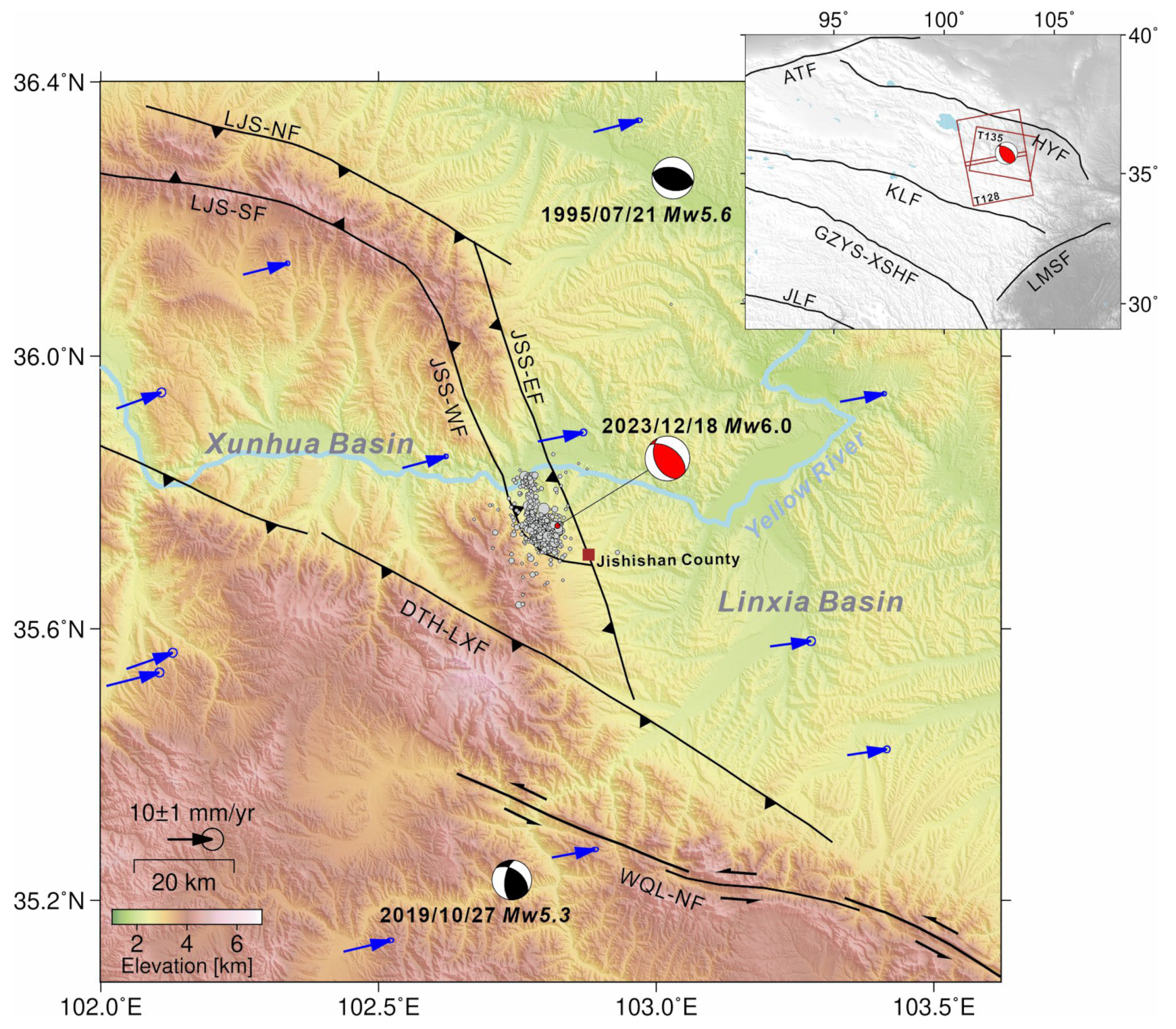

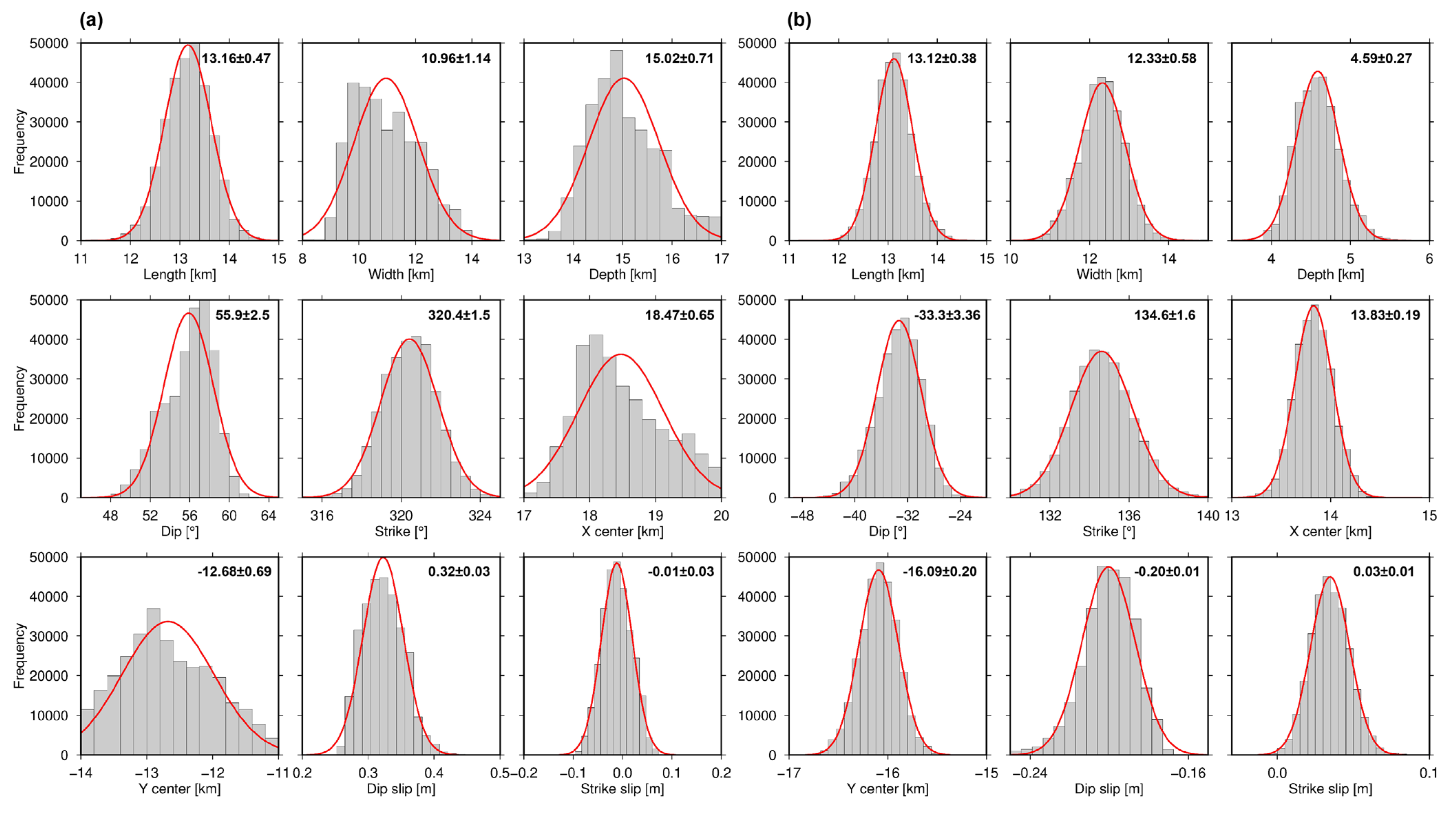
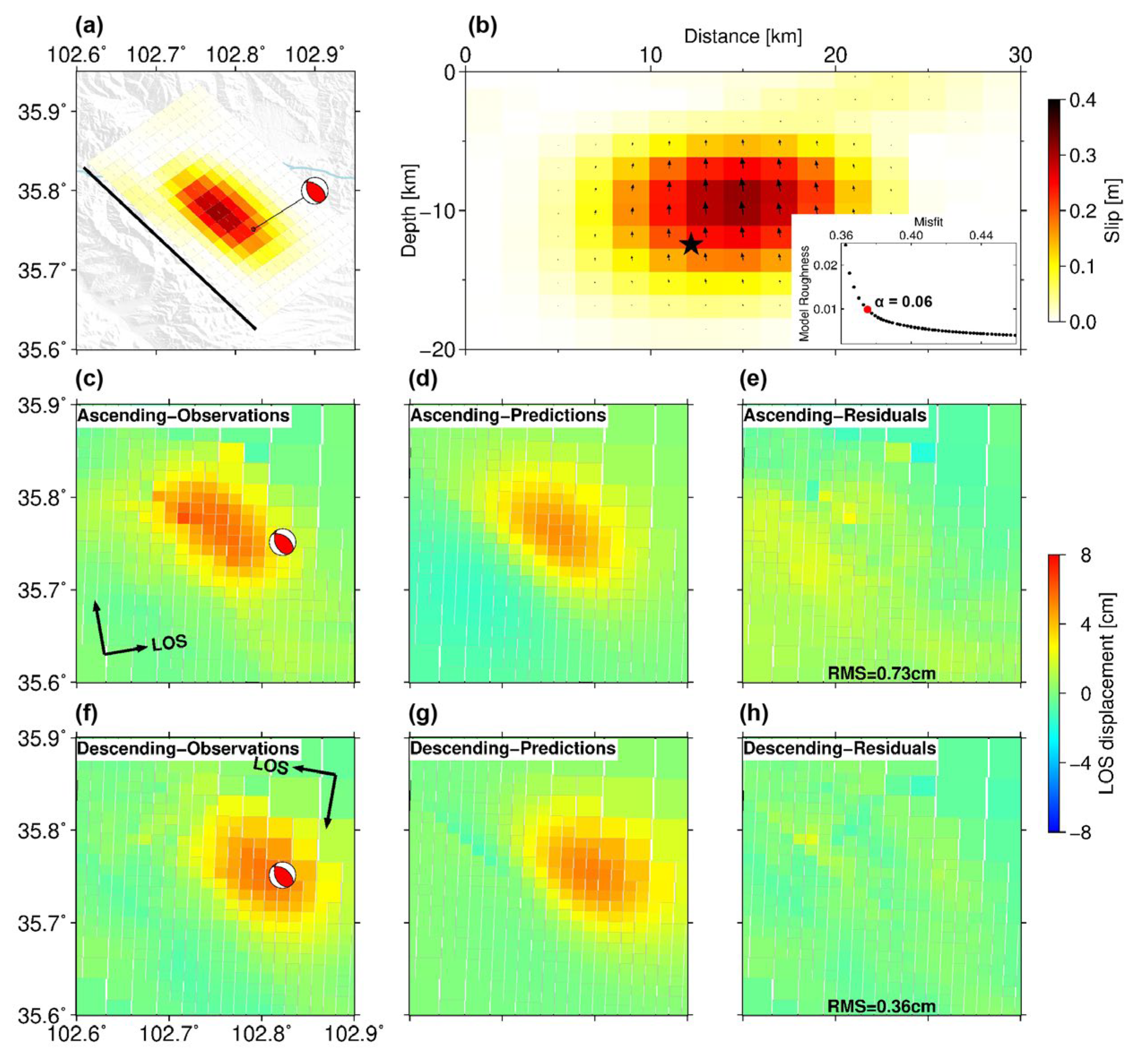

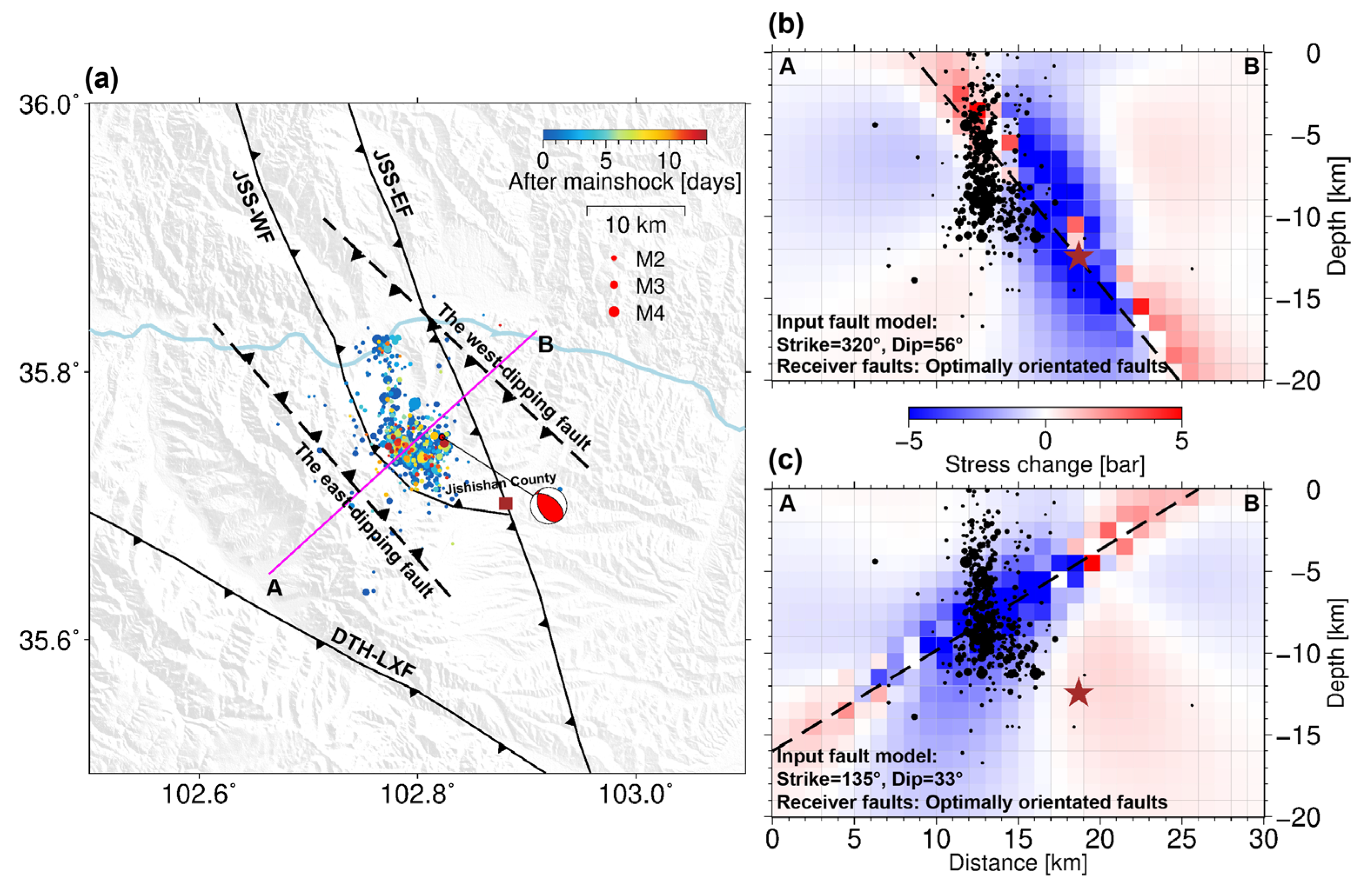
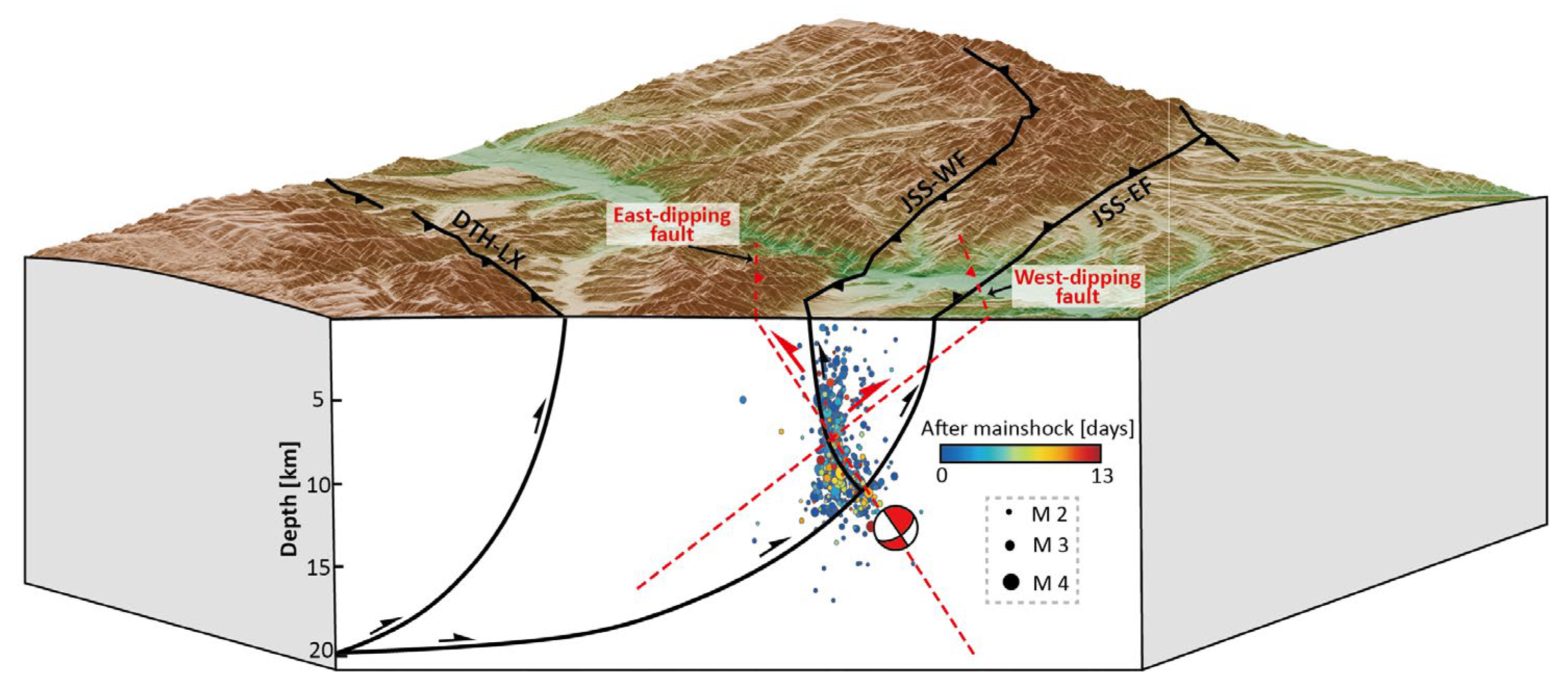
| Length/m | Width/m | Depth/m | Dip 1/° | Dip 2/° | Strike/° | X Center/m | Y Center/m | Strike Slip/m | Dip Slip/m | |
|---|---|---|---|---|---|---|---|---|---|---|
| Lower | 5000 | 5000 | 2000 | 0 | −90 | 90 | 10,000 | −20,000 | −0.5 | −1.0 |
| Upper | 20,000 | 20,000 | 20,000 | 90 | 0 | 360 | 20,000 | −10,000 | 0.5 | 1.0 |
| Optimal 1 | 13,162 | 10,963 | 15,025 | 55.9 | \ | 320.4 | 18,474 | −12,678 | −0.01 | 0.32 |
| Optimal 2 | 13,123 | 12,326 | 4585 | \ | −33.3 | 134.6 | 13,828 | −16,092 | 0.03 | −0.20 |
Disclaimer/Publisher’s Note: The statements, opinions and data contained in all publications are solely those of the individual author(s) and contributor(s) and not of MDPI and/or the editor(s). MDPI and/or the editor(s) disclaim responsibility for any injury to people or property resulting from any ideas, methods, instructions or products referred to in the content. |
© 2024 by the authors. Licensee MDPI, Basel, Switzerland. This article is an open access article distributed under the terms and conditions of the Creative Commons Attribution (CC BY) license (https://creativecommons.org/licenses/by/4.0/).
Share and Cite
Huang, X.; Li, Y.; Shan, X.; Zhong, M.; Wang, X.; Gao, Z. Fault Kinematics of the 2023 Mw 6.0 Jishishan Earthquake, China, Characterized by Interferometric Synthetic Aperture Radar Observations. Remote Sens. 2024, 16, 1746. https://doi.org/10.3390/rs16101746
Huang X, Li Y, Shan X, Zhong M, Wang X, Gao Z. Fault Kinematics of the 2023 Mw 6.0 Jishishan Earthquake, China, Characterized by Interferometric Synthetic Aperture Radar Observations. Remote Sensing. 2024; 16(10):1746. https://doi.org/10.3390/rs16101746
Chicago/Turabian StyleHuang, Xing, Yanchuan Li, Xinjian Shan, Meijiao Zhong, Xuening Wang, and Zhiyu Gao. 2024. "Fault Kinematics of the 2023 Mw 6.0 Jishishan Earthquake, China, Characterized by Interferometric Synthetic Aperture Radar Observations" Remote Sensing 16, no. 10: 1746. https://doi.org/10.3390/rs16101746
APA StyleHuang, X., Li, Y., Shan, X., Zhong, M., Wang, X., & Gao, Z. (2024). Fault Kinematics of the 2023 Mw 6.0 Jishishan Earthquake, China, Characterized by Interferometric Synthetic Aperture Radar Observations. Remote Sensing, 16(10), 1746. https://doi.org/10.3390/rs16101746







